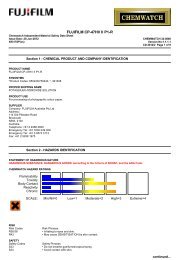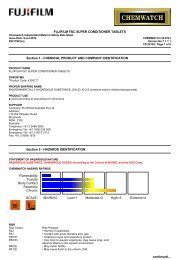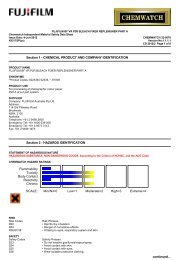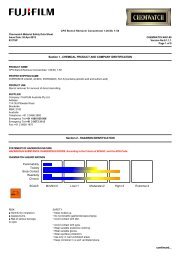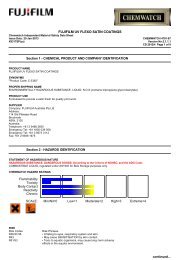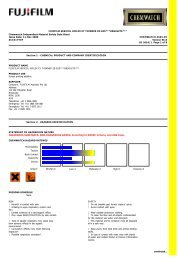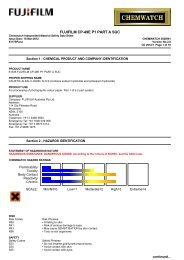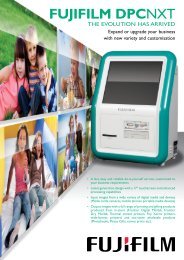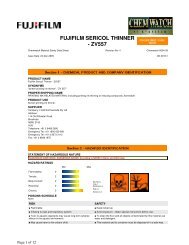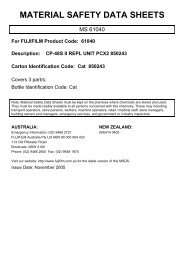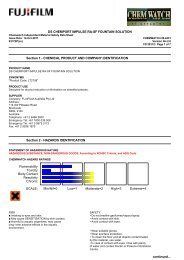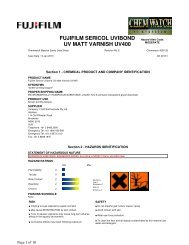Chemwatch MSDS Print - FUJIFILM Australia
Chemwatch MSDS Print - FUJIFILM Australia
Chemwatch MSDS Print - FUJIFILM Australia
Create successful ePaper yourself
Turn your PDF publications into a flip-book with our unique Google optimized e-Paper software.
ZINC SULFIDE, COPPER CHLORIDE ACTIVATED<br />
<strong>Chemwatch</strong> Material Safety Data Sheet<br />
Issue Date: 19-Oct-2012 CHEMWATCH 4066-76<br />
9317SP<br />
Version No:5.1.1.1<br />
Page 1 of 8<br />
Section 1 - CHEMICAL PRODUCT AND COMPANY IDENTIFICATION<br />
PRODUCT NAME<br />
ZINC SULFIDE, COPPER CHLORIDE ACTIVATED<br />
SYNONYMS<br />
"Lumilux Effect Green N-FG", "zinc sulphide, copper-doped", "Glo-Lux Series 1000"<br />
PROPER SHIPPING NAME<br />
ENVIRONMENTALLY HAZARDOUS SUBSTANCE, SOLID, N.O.S.(contains zinc sulfide, copper chloride activated)<br />
PRODUCT NUMBERS<br />
GLOPOWDER<br />
PRODUCT USE<br />
Phosphor in x-ray and television screens.<br />
Intermediate<br />
SUPPLIER<br />
Company: <strong>FUJIFILM</strong> <strong>Australia</strong> Pty Ltd<br />
Address:<br />
114 Old Pittwater Road<br />
Brookvale<br />
NSW, 2100<br />
<strong>Australia</strong><br />
Telephone: +61 2 9466 2600<br />
Emergency Tel:+61 1800 039 008<br />
Fax: +61 2 9938 1975<br />
Section 2 - HAZARDS IDENTIFICATION<br />
STATEMENT OF HAZARDOUS NATURE<br />
DANGEROUS GOODS. NON-HAZARDOUS SUBSTANCE. According to NOHSC Criteria, and ADG Code.<br />
CHEMWATCH HAZARD RATINGS<br />
Flammability<br />
Toxicity<br />
Body Contact<br />
Reactivity<br />
Chronic<br />
SCALE: Min/Nil=0 Low=1 Moderate=2 High=3 Extreme=4<br />
RISK<br />
■ Very toxic to aquatic<br />
organisms.<br />
SAFETY<br />
• Do not empty into drains.<br />
• To clean the floor and all objects contaminated by this material,<br />
use water and detergent.<br />
continued...
ZINC SULFIDE, COPPER CHLORIDE ACTIVATED<br />
<strong>Chemwatch</strong> Material Safety Data Sheet<br />
Issue Date: 19-Oct-2012 CHEMWATCH 4066-76<br />
9317SP<br />
Version No:5.1.1.1<br />
Page 2 of 8<br />
Section 2 - HAZARDS IDENTIFICATION<br />
• This material and its container must be disposed of in a safe way.<br />
• Use appropriate container to avoid environmental contamination.<br />
• Avoid release to the environment. Refer to special<br />
instructions/Safety data sheets.<br />
• This material and its container must be disposed of as hazardous<br />
waste.<br />
Section 3 - COMPOSITION / INFORMATION ON INGREDIENTS<br />
NAME CAS RN %<br />
zinc sulfide, copper chloride activated 68611-70-1 >98<br />
Section 4 - FIRST AID MEASURES<br />
SWALLOWED<br />
• If swallowed do NOT induce vomiting.<br />
• If vomiting occurs, lean patient forward or place on left side (head-down position, if possible) to maintain open airway and<br />
prevent aspiration.<br />
• Observe the patient carefully.<br />
• Never give liquid to a person showing signs of being sleepy or with reduced awareness; i.e. becoming unconscious.<br />
EYE<br />
■ If this product comes in contact with the eyes:<br />
• Wash out immediately with fresh running water.<br />
• Ensure complete irrigation of the eye by keeping eyelids apart and away from eye and moving the eyelids by occasionally lifting<br />
the upper and lower lids.<br />
• Seek medical attention without delay; if pain persists or recurs seek medical attention.<br />
• Removal of contact lenses after an eye injury should only be undertaken by skilled personnel.<br />
SKIN<br />
■ If skin contact occurs:<br />
• Immediately remove all contaminated clothing, including footwear.<br />
• Flush skin and hair with running water (and soap if available).<br />
• Seek medical attention in event of irritation.<br />
INHALED<br />
• If fumes or combustion products are inhaled remove from contaminated area.<br />
• Lay patient down. Keep warm and rested.<br />
• Prostheses such as false teeth, which may block airway, should be removed, where possible, prior to initiating first aid<br />
procedures.<br />
• Apply artificial respiration if not breathing, preferably with a demand valve resuscitator, bag-valve mask device, or pocket<br />
mask as trained. Perform CPR if necessary.<br />
NOTES TO PHYSICIAN<br />
• Absorption of zinc compounds occurs in the small intestine.<br />
• The metal is heavily protein bound.<br />
• Elimination results primarily from faecal excretion.<br />
• The usual measures for decontamination (Ipecac Syrup, lavage, charcoal or cathartics) may be administered, although patients<br />
usually have sufficient vomiting not to require them.<br />
For exposures involving sulfides and hydrogen sulfide (including gastric acid decomposition products of alkaline sulfides):<br />
• Hydrogen sulfide anion produces its major toxic effect through inhibition of cytochrome oxidases.<br />
• Symptoms include profuse salivation, nausea, vomiting and diarrhea. Central nervous effects may include giddiness, headache,<br />
vertigo, amnesia, confusion and unconsciousness. Tachypnoea, palpitations, tachycardia, arrhythmia, sweating, weakness and<br />
muscle cramps may also indicate overexposure.<br />
Treatment involves:<br />
• If respirations are depressed, application of artificial respiration, administration of oxygen (continue after spontaneous<br />
breathing is established).<br />
• For severe poisonings administer amyl nitrite and sodium nitrite (as for cyanide poisoning) but omit sodium thiosulfate<br />
injection.<br />
continued...
ZINC SULFIDE, COPPER CHLORIDE ACTIVATED<br />
<strong>Chemwatch</strong> Material Safety Data Sheet<br />
Issue Date: 19-Oct-2012 CHEMWATCH 4066-76<br />
9317SP<br />
Version No:5.1.1.1<br />
Page 3 of 8<br />
Section 5 - FIRE FIGHTING MEASURES<br />
EXTINGUISHING MEDIA<br />
• Water spray or fog.<br />
• Foam.<br />
• Dry chemical powder.<br />
• BCF (where regulations permit).<br />
FIRE FIGHTING<br />
• Alert Fire Brigade and tell them location and nature of hazard.<br />
• Wear breathing apparatus plus protective gloves in the event of a fire.<br />
• Prevent, by any means available, spillage from entering drains or water courses.<br />
• Use fire fighting procedures suitable for surrounding area.<br />
FIRE/EXPLOSION HAZARD<br />
• Non combustible.<br />
• Not considered a significant fire risk, however containers may burn.<br />
Decomposition may produce toxic fumes of: sulfur oxides (SOx), sulfur dioxide (SO2), hydrogen sulfide (H2S), metal oxides.<br />
FIRE INCOMPATIBILITY<br />
■ None known.<br />
HAZCHEM<br />
2Z<br />
Section 6 - ACCIDENTAL RELEASE MEASURES<br />
MINOR SPILLS<br />
• Remove all ignition sources.<br />
• Clean up all spills immediately.<br />
• Avoid contact with skin and eyes.<br />
• Control personal contact with the substance, by using protective equipment.<br />
Environmental hazard - contain spillage.<br />
MAJOR SPILLS<br />
Environmental hazard - contain spillage.<br />
Moderate hazard.<br />
• CAUTION: Advise personnel in area.<br />
• Alert Emergency Services and tell them location and nature of hazard.<br />
• Control personal contact by wearing protective clothing.<br />
• Prevent, by any means available, spillage from entering drains or water courses.<br />
Personal Protective Equipment advice is contained in Section 8 of the <strong>MSDS</strong>.<br />
Section 7 - HANDLING AND STORAGE<br />
PROCEDURE FOR HANDLING<br />
• Avoid all personal contact, including inhalation.<br />
• Wear protective clothing when risk of exposure occurs.<br />
• Use in a well-ventilated area.<br />
• Prevent concentration in hollows and sumps.<br />
SUITABLE CONTAINER<br />
• Polyethylene or polypropylene container.<br />
• Check all containers are clearly labelled and free from leaks.<br />
STORAGE INCOMPATIBILITY<br />
• WARNING: Avoid or control reaction with peroxides. All transition metal peroxides should be considered as potentially<br />
explosive. For example transition metal complexes of alkyl hydroperoxides may decompose explosively.<br />
• The pi-complexes formed between chromium(0), vanadium(0) and other transition metals (haloarene-metal complexes) and mono-or<br />
poly-fluorobenzene show extreme sensitivity to heat and are explosive.<br />
• Avoid reaction with borohydrides or cyanoborohydrides.<br />
continued...
ZINC SULFIDE, COPPER CHLORIDE ACTIVATED<br />
<strong>Chemwatch</strong> Material Safety Data Sheet<br />
Issue Date: 19-Oct-2012 CHEMWATCH 4066-76<br />
9317SP<br />
Version No:5.1.1.1<br />
Page 4 of 8<br />
Section 7 - HANDLING AND STORAGE<br />
• Contact with acids produces toxic fumes.<br />
• Sulfides are incompatible with acids, diazo and azo compounds, halocarbons, isocyanates, aldehydes, alkali metals, nitrides,<br />
hydrides, and other strong reducing agents.<br />
• Many reactions of sulfides with these materials generate heat and in many cases hydrogen gas.<br />
• Many sulfide compounds may liberate hydrogen sulfide upon reaction with an acid.<br />
• Metals and their oxides or salts may react violently with chlorine trifluoride and bromine trifluoride.<br />
• These trifluorides are hypergolic oxidisers. They ignites on contact (without external source of heat or ignition) with<br />
recognised fuels - contact with these materials, following an ambient or slightly elevated temperature, is often violent and<br />
may produce ignition.<br />
• The state of subdivision may affect the results.<br />
PACKAGING MATERIAL INCOMPATIBILITIES<br />
Chemical Name<br />
Container Type<br />
" Acetal (Delrinr)" , " Cast iron" , Neoprene<br />
STORAGE REQUIREMENTS<br />
• Store in original containers.<br />
• Keep containers securely sealed.<br />
• Store in a cool, dry area protected from environmental extremes.<br />
• Store away from incompatible materials and foodstuff containers.<br />
Section 8 - EXPOSURE CONTROLS / PERSONAL PROTECTION<br />
EXPOSURE CONTROLS<br />
Source Material TWA TWA STEL STEL Peak Peak TWA Notes<br />
ppm mg/m³ ppm mg/m³ ppm mg/m³ F/CC<br />
__________ __________ ______ ______ ______ ______ ______ ______ ______ ______<br />
<strong>Australia</strong> (Copper, dusts & 1<br />
Exposure<br />
mists (as Cu))<br />
Standards<br />
<strong>Australia</strong> (Copper (fume)) 0.2<br />
Exposure<br />
Standards<br />
MATERIAL DATA<br />
ZINC SULFIDE, COPPER CHLORIDE ACTIVATED:<br />
PERSONAL PROTECTION<br />
RESPIRATOR<br />
•Particulate. (AS/NZS 1716 & 1715, EN 143:2000 & 149:2001, ANSI Z88 or national equivalent)<br />
EYE<br />
• Safety glasses with side shields.<br />
• Chemical goggles.<br />
• Contact lenses may pose a special hazard; soft contact lenses may absorb and concentrate irritants. A written policy document,<br />
describing the wearing of lens or restrictions on use, should be created for each workplace or task. This should include a<br />
review of lens absorption and adsorption for the class of chemicals in use and an account of injury experience. Medical and<br />
first-aid personnel should be trained in their removal and suitable equipment should be readily available. In the event of<br />
chemical exposure, begin eye irrigation immediately and remove contact lens as soon as practicable. Lens should be removed at<br />
the first signs of eye redness or irritation - lens should be removed in a clean environment only after workers have washed<br />
hands thoroughly. [CDC NIOSH Current Intelligence Bulletin 59], [AS/NZS 1336 or national equivalent].<br />
HANDS/FEET<br />
• Wear chemical protective gloves, e.g. PVC.<br />
• Wear safety footwear or safety gumboots, e.g. Rubber.<br />
The selection of the suitable gloves does not only depend on the material, but also on further marks of quality which vary from<br />
manufacturer to manufacturer. Where the chemical is a preparation of several substances, the resistance of the glove material can<br />
not be calculated in advance and has therefore to be checked prior to the application.<br />
The exact break through time for substances has to be obtained from the manufacturer of the protective gloves and<br />
continued...
ZINC SULFIDE, COPPER CHLORIDE ACTIVATED<br />
<strong>Chemwatch</strong> Material Safety Data Sheet<br />
Issue Date: 19-Oct-2012 CHEMWATCH 4066-76<br />
9317SP<br />
Version No:5.1.1.1<br />
Page 5 of 8<br />
Section 8 - EXPOSURE CONTROLS / PERSONAL PROTECTION<br />
has to be observed when making a final choice.<br />
Suitability and durability of glove type is dependent on usage. Important factors in the selection of gloves include:<br />
OTHER<br />
• Overalls.<br />
• P.V.C. apron.<br />
• Barrier cream.<br />
• Skin cleansing cream.<br />
ENGINEERING CONTROLS<br />
■ Engineering controls are used to remove a hazard or place a barrier between the worker and the hazard. Well-designed<br />
engineering controls can be highly effective in protecting workers and will typically be independent of worker interactions to<br />
provide this high level of protection.<br />
The basic types of engineering controls are:<br />
Process controls which involve changing the way a job activity or process is done to reduce the risk.<br />
Enclosure and/or isolation of emission source which keeps a selected hazard "physically" away from the worker and ventilation<br />
that strategically "adds" and "removes" air in the work environment.<br />
Section 9 - PHYSICAL AND CHEMICAL PROPERTIES<br />
APPEARANCE<br />
Yellow to green solid; does not mix with water. Sublimes at 1185 C.<br />
PHYSICAL PROPERTIES<br />
Solid.<br />
Does not mix with water.<br />
Sinks in water.<br />
State Divided solid Molecular Weight Not available.<br />
Melting Range (°C) 1680- 1720; 60atm Viscosity Not Applicable<br />
Boiling Range (°C) Not available Solubility in water (g/L) Immiscible<br />
Flash Point (°C) Not applicable pH (1% solution) Not applicable.<br />
Decomposition Temp (°C) >600 pH (as supplied) Not applicable<br />
Autoignition Temp (°C) Not applicable Vapour Pressure (kPa) Not applicable.<br />
Upper Explosive Limit (%) Not applicable Specific Gravity (water=1) 4.06<br />
Lower Explosive Limit (%) Not applicable Relative Vapour Density Not applicable.<br />
(air=1)<br />
Volatile Component (%vol) Not applicable. Evaporation Rate Not applicable<br />
Section 10 - STABILITY AND REACTIVITY<br />
CONDITIONS CONTRIBUTING TO INSTABILITY<br />
• Presence of incompatible materials.<br />
• Product is considered stable.<br />
• Hazardous polymerisation will not occur.<br />
For incompatible materials - refer to Section 7 - Handling and Storage.<br />
Section 11 - TOXICOLOGICAL INFORMATION<br />
POTENTIAL HEALTH EFFECTS<br />
ACUTE HEALTH EFFECTS<br />
SWALLOWED<br />
■ Accidental ingestion of the material may be damaging to the health of the individual.<br />
Soluble zinc salts produce irritation and corrosion of the alimentary tract with pain, and vomiting. Death can occur due to<br />
insufficiency of food intake due to severe narrowing of the oesophagus and pylorus.<br />
If ingested, sulfide salts can form hydrogen sulfide, causing headache, cyanosis, low blood pressure, loss of consciousness,<br />
tremors and convulsions.<br />
continued...
ZINC SULFIDE, COPPER CHLORIDE ACTIVATED<br />
<strong>Chemwatch</strong> Material Safety Data Sheet<br />
Issue Date: 19-Oct-2012 CHEMWATCH 4066-76<br />
9317SP<br />
Version No:5.1.1.1<br />
Page 6 of 8<br />
Section 11 - TOXICOLOGICAL INFORMATION<br />
EYE<br />
■ There is some evidence to suggest that this material can cause eye irritation and damage in some persons.<br />
SKIN<br />
■ Skin contact is not thought to have harmful health effects (as classified under EC Directives); the material may still produce<br />
health damage following entry through wounds, lesions or abrasions.<br />
There is some evidence to suggest that this material can cause inflammation of the skin on contact in some persons.<br />
Entry into the blood-stream, through, for example, cuts, abrasions or lesions, may produce systemic injury with harmful effects.<br />
Examine the skin prior to the use of the material and ensure that any external damage is suitably protected.<br />
INHALED<br />
■ Inhalation of dusts, generated by the material during the course of normal handling, may be damaging to the health of the<br />
individual.<br />
There is some evidence to suggest that the material can cause respiratory irritation in some persons. The body's response to such<br />
irritation can cause further lung damage.<br />
Persons with impaired respiratory function, airway diseases and conditions such as emphysema or chronic bronchitis, may incur<br />
further disability if excessive concentrations of particulate are inhaled.<br />
If prior damage to the circulatory or nervous systems has occurred or if kidney damage has been sustained, proper screenings<br />
should be conducted on individuals who may be exposed to further risk if handling and use of the material result<br />
in excessive exposures.<br />
CHRONIC HEALTH EFFECTS<br />
■ Substance accumulation, in the human body, may occur and may cause some concern following repeated or long-term occupational<br />
exposure.<br />
Long term exposure to high dust concentrations may cause changes in lung function i.e. pneumoconiosis; caused by particles less<br />
than 0.5 micron penetrating and remaining in the lung. Prime symptom is breathlessness; lung shadows show on X-ray.<br />
Welding or flame cutting of metals with zinc or zinc dust coatings may result in inhalation of zinc oxide fume; high<br />
concentrations of zinc oxide fume may result in "metal fume fever"; also known as "brass chills", an industrial disease of short<br />
duration. [I.L.O] Symptoms include malaise, fever, weakness, nausea and may appear quickly if operations occur in enclosed or<br />
poorly ventilated areas.<br />
TOXICITY AND IRRITATION<br />
No data for this material.<br />
Section 12 - ECOLOGICAL INFORMATION<br />
Very toxic to aquatic organisms.<br />
This material and its container must be disposed of as hazardous waste.<br />
Avoid release to the environment.<br />
Refer to special instructions/ safety data sheets.<br />
Ecotoxicity<br />
Ingredient Persistence: Persistence: Air Bioaccumulation Mobility<br />
Water/Soil<br />
ZINC SULFIDE, COPPER CHLORIDE No Data No Data No Data No Data<br />
ACTIVATED Available Available Available Available<br />
Section 13 - DISPOSAL CONSIDERATIONS<br />
■ Legislation addressing waste disposal requirements may differ by country, state and/ or territory. Each user must refer to laws<br />
operating in their area.<br />
A Hierarchy of Controls seems to be common - the user should investigate:<br />
• Reduction.<br />
• DO NOT allow wash water from cleaning or process equipment to enter drains.<br />
• It may be necessary to collect all wash water for treatment before disposal.<br />
• In all cases disposal to sewer may be subject to local laws and regulations and these should be considered first.<br />
• Where in doubt contact the responsible authority.<br />
• Recycle wherever possible or consult manufacturer for recycling options.<br />
• Consult State Land Waste Management Authority for disposal.<br />
• Bury residue in an authorised landfill.<br />
• Recycle containers if possible, or dispose of in an authorised landfill.<br />
continued...
ZINC SULFIDE, COPPER CHLORIDE ACTIVATED<br />
<strong>Chemwatch</strong> Material Safety Data Sheet<br />
Issue Date: 19-Oct-2012 CHEMWATCH 4066-76<br />
9317SP<br />
Version No:5.1.1.1<br />
Page 7 of 8<br />
Section 14 - TRANSPORTATION INFORMATION<br />
■ Environmentally Hazardous Substances meeting the descriptions of UN 3077 or UN 3082<br />
are not subject to this Code when transported by road or rail in;<br />
(a) packagings;<br />
(b) IBCs; or<br />
(c) any other receptacle not exceeding 500 kg(L).<br />
- <strong>Australia</strong>n Special Provisions (SP AU01) - ADG Code 7th Ed.<br />
Labels Required: MISCELLANEOUS<br />
HAZCHEM:<br />
2Z (ADG7)<br />
Land Transport UNDG:<br />
Class or division: 9 Subsidiary risk: None<br />
UN No.: 3077 UN packing group: III<br />
Shipping Name:ENVIRONMENTALLY HAZARDOUS SUBSTANCE, SOLID, N.O.S.<br />
(contains zinc sulfide, copper chloride activated)<br />
Air Transport IATA:<br />
ICAO/IATA Class: 9 ICAO/IATA Subrisk: None<br />
UN/ID Number: 3077 Packing Group: III<br />
Special provisions:<br />
A97<br />
Cargo Only<br />
Packing Instructions: 956 Maximum Qty/Pack: 400 kg<br />
Passenger and Cargo<br />
Passenger and Cargo<br />
Packing Instructions: 956 Maximum Qty/Pack: 400 kg<br />
Passenger and Cargo Limited Quantity<br />
Passenger and Cargo Limited Quantity<br />
Packing Instructions: Y956 Maximum Qty/Pack: 30 kg G<br />
Shipping name:ENVIRONMENTALLY HAZARDOUS SUBSTANCE, SOLID, N.O.S.(contains zinc sulfide, copper chloride activated)<br />
Maritime Transport IMDG:<br />
IMDG Class: 9 IMDG Subrisk: None<br />
UN Number: 3077 Packing Group: III<br />
EMS Number: F-A,S-F Special provisions: 274 335<br />
Limited Quantities: 5 kg Marine Pollutant: Yes<br />
Shipping name:ENVIRONMENTALLY HAZARDOUS SUBSTANCE, SOLID, N.O.S.(contains zinc sulfide, copper chloride activated)<br />
Section 15 - REGULATORY INFORMATION<br />
Indications of Danger:<br />
N Dangerous for the environment<br />
POISONS SCHEDULE<br />
None<br />
REGULATIONS<br />
ZINC SULFIDE, COPPER CHLORIDE ACTIVATED (CAS: 68611-70-1) is found on the following regulatory<br />
lists;<br />
"<strong>Australia</strong> - <strong>Australia</strong>n Capital Territory - Environment Protection Regulation: Ambient environmental standards (Domestic water<br />
supply - inorganic chemicals)", "<strong>Australia</strong> - <strong>Australia</strong>n Capital Territory - Environment Protection Regulation: Ambient<br />
environmental standards (STOCK - inorganic chemicals)", "<strong>Australia</strong> - <strong>Australia</strong>n Capital Territory - Environment Protection<br />
Regulation: Pollutants entering waterways taken to cause environmental harm - Domestic water supply quality", "<strong>Australia</strong> -<br />
<strong>Australia</strong>n Capital Territory - Environment Protection Regulation: Pollutants entering waterways taken to cause environmental harm<br />
(IRRIG)", "<strong>Australia</strong> - <strong>Australia</strong>n Capital Territory - Environment Protection Regulation: Pollutants entering waterways taken to<br />
cause environmental harm (STOCK)", "<strong>Australia</strong> Drinking Water Guideline Values For Physical and Chemical Characteristics",<br />
"<strong>Australia</strong> Exposure Standards", "<strong>Australia</strong> Inventory of Chemical Substances (AICS)", "<strong>Australia</strong> National Pollutant Inventory",<br />
continued...
ZINC SULFIDE, COPPER CHLORIDE ACTIVATED<br />
<strong>Chemwatch</strong> Material Safety Data Sheet<br />
Issue Date: 19-Oct-2012 CHEMWATCH 4066-76<br />
9317SP<br />
Version No:5.1.1.1<br />
Page 8 of 8<br />
Section 15 - REGULATORY INFORMATION<br />
"<strong>Australia</strong> Standard for the Uniform Scheduling of Medicines and Poisons (SUSMP) - Appendix A", "<strong>Australia</strong> Standard for the<br />
Uniform Scheduling of Medicines and Poisons (SUSMP) - Schedule 4", "<strong>Australia</strong> Standard for the Uniform Scheduling of Medicines<br />
and Poisons (SUSMP) - Schedule 5", "<strong>Australia</strong> Standard for the Uniform Scheduling of Medicines and Poisons (SUSMP) - Schedule 6",<br />
"International Maritime Dangerous Goods Requirements (IMDG Code) - Substance Index", "WHO Guidelines for Drinking-water Quality -<br />
Chemicals for which guideline values have not been established"<br />
Section 16 - OTHER INFORMATION<br />
■ Classification of the preparation and its individual components has drawn on official and authoritative sources as well as<br />
independent review by the <strong>Chemwatch</strong> Classification committee using available literature references.<br />
A list of reference resources used to assist the committee may be found at:<br />
www.chemwatch.net/references.<br />
■ The (M)SDS is a Hazard Communication tool and should be used to assist in the Risk Assessment. Many factors determine whether<br />
the reported Hazards are Risks in the workplace or other settings.<br />
This document is copyright. Apart from any fair dealing for the purposes of private study, research, review or<br />
criticism, as permitted under the Copyright Act, no part may be reproduced by any process without written<br />
permission from CHEMWATCH. TEL (+61 3) 9572 4700.<br />
Issue Date: 19-Oct-2012<br />
<strong>Print</strong> Date: 3-Dec-2012<br />
This is the end of the <strong>MSDS</strong>.



